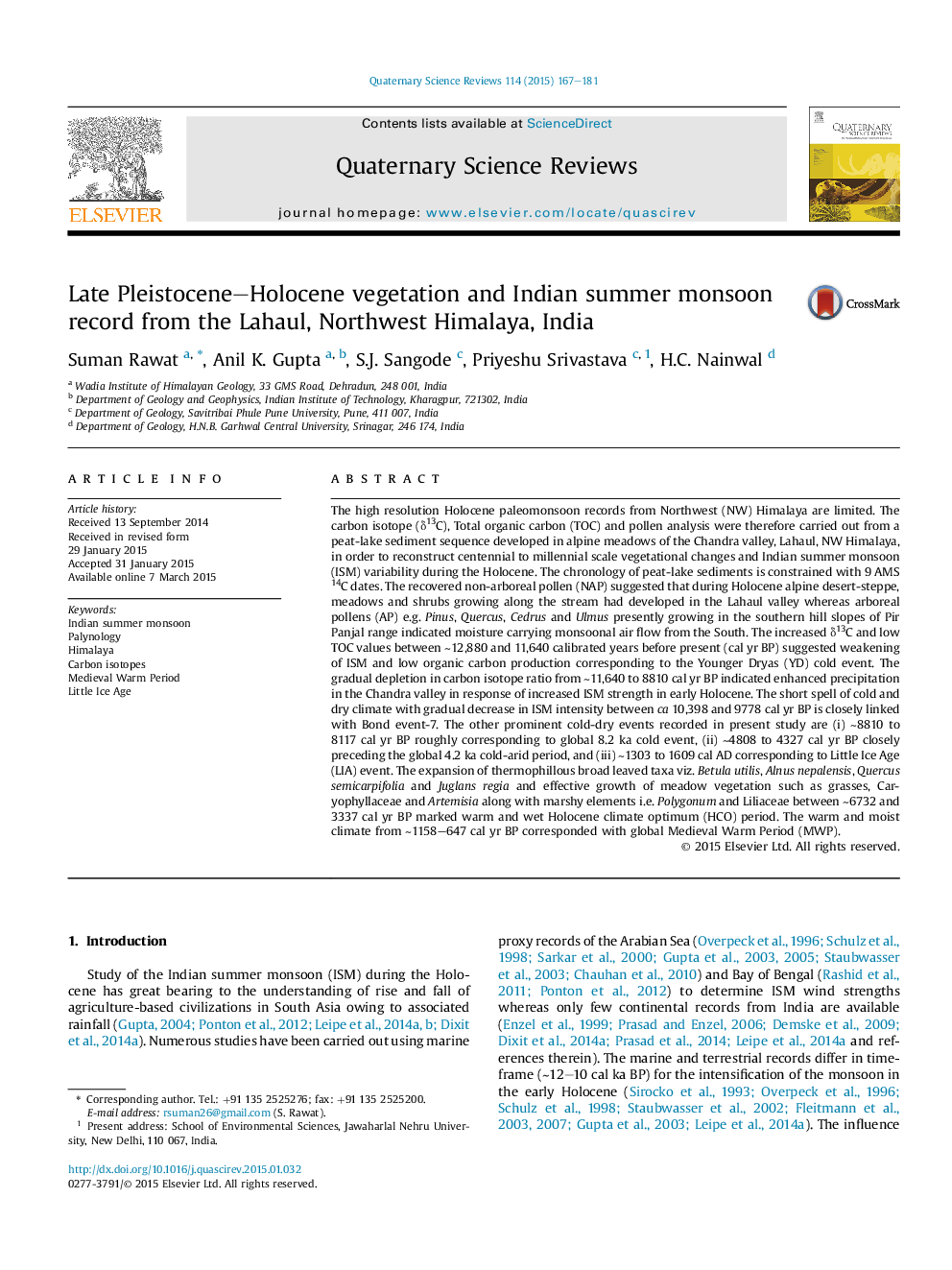| کد مقاله | کد نشریه | سال انتشار | مقاله انگلیسی | نسخه تمام متن |
|---|---|---|---|---|
| 4736390 | 1640820 | 2015 | 15 صفحه PDF | دانلود رایگان |
• First high resolution Holocene vegetation and ISM records from Lahaul, NW Himalaya.
• The cold-dry and weak ISM phases were recorded during YD, 10.3 ka, 8.2 ka, and LIA.
• The intensified ISM was recorded during early Holocene (∼11,640–8810 cal yr BP).
• The Holocene climate optimum was recorded between ∼6732 and 3337 cal yr BP.
• The Medieval Warm Period in Lahaul Himalaya prevailed from ∼1158–647 cal yr BP.
The high resolution Holocene paleomonsoon records from Northwest (NW) Himalaya are limited. The carbon isotope (δ13C), Total organic carbon (TOC) and pollen analysis were therefore carried out from a peat-lake sediment sequence developed in alpine meadows of the Chandra valley, Lahaul, NW Himalaya, in order to reconstruct centennial to millennial scale vegetational changes and Indian summer monsoon (ISM) variability during the Holocene. The chronology of peat-lake sediments is constrained with 9 AMS 14C dates. The recovered non-arboreal pollen (NAP) suggested that during Holocene alpine desert-steppe, meadows and shrubs growing along the stream had developed in the Lahaul valley whereas arboreal pollens (AP) e.g. Pinus, Quercus, Cedrus and Ulmus presently growing in the southern hill slopes of Pir Panjal range indicated moisture carrying monsoonal air flow from the South. The increased δ13C and low TOC values between ∼12,880 and 11,640 calibrated years before present (cal yr BP) suggested weakening of ISM and low organic carbon production corresponding to the Younger Dryas (YD) cold event. The gradual depletion in carbon isotope ratio from ∼11,640 to 8810 cal yr BP indicated enhanced precipitation in the Chandra valley in response of increased ISM strength in early Holocene. The short spell of cold and dry climate with gradual decrease in ISM intensity between ca 10,398 and 9778 cal yr BP is closely linked with Bond event-7. The other prominent cold-dry events recorded in present study are (i) ∼8810 to 8117 cal yr BP roughly corresponding to global 8.2 ka cold event, (ii) ∼4808 to 4327 cal yr BP closely preceding the global 4.2 ka cold-arid period, and (iii) ∼1303 to 1609 cal AD corresponding to Little Ice Age (LIA) event. The expansion of thermophillous broad leaved taxa viz. Betula utilis, Alnus nepalensis, Quercus semicarpifolia and Juglans regia and effective growth of meadow vegetation such as grasses, Caryophyllaceae and Artemisia along with marshy elements i.e. Polygonum and Liliaceae between ∼6732 and 3337 cal yr BP marked warm and wet Holocene climate optimum (HCO) period. The warm and moist climate from ∼1158–647 cal yr BP corresponded with global Medieval Warm Period (MWP).
Journal: Quaternary Science Reviews - Volume 114, 15 April 2015, Pages 167–181
